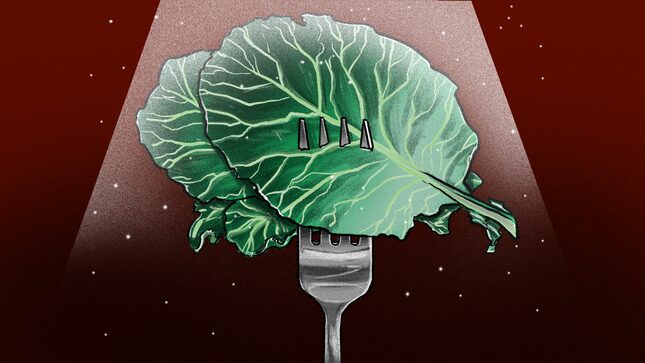An Ode to the Cabbage, a Worthy and Delicious Brassica
Latest
Illustration: Benjamin Currie
The National Palace Museum in Taipei is a hulking edifice plunked into the side of a mountain, designed to look like an actual palace, though it is just a museum and nothing more. Deep within its walls are various treasures, most of which I found uninteresting when I visited in the winter of 2018, on a tedious but ultimately rewarding trip with my family. In general, we are not a museum-going bunch, but the weather was spitting rain and humid, and the museum a good place to kill a little time before heading to a night market, to eat as much chou doufu as possible before waddling back to our Airbnb. Rounding a corner I stumbled upon what appeared to be the hottest ticket in town, indicated by the large group of tourists crowding around a vitrine in the middle of a darkened room, cameras phones at the ready. They were straining to get a glimpse of the museum’s most popular—and prized—attraction: the Jadeite cabbage.
Part of the spoils brought to Taiwan by the Kuomintang in 1949, the cabbage had been packed amongst crates full of imperial treasures taken from the Forbidden Palace after the end of the Chinese Civil War. The Mandarin word for “cabbage” is baicai, which sounds similar to the word for “hundred wealth.” Cabbage is traditionally a symbol of prosperity and so the fact that the Jadeite Cabbage is the star of the show makes perfect sense. Still, I was bemused that tourists were clamoring to see a small cabbage carved from stone. Because I was bored and likely hungry, I waited for the crowds to part before muscling up to the front to see what all the fuss was about.

Up close, the cabbage was beautiful. Jade is most valuable when the stone itself lacks imperfections, as my mother has informed me many times. The anonymous artist who created the piece understood the nature of the raw material innately, using the cracks and blemishes to create a remarkably realistic rendition of a bok choy, in its wrinkly, multi-dimensional glory. Pressing my face close to the glass, I saw that there were two insects perched atop its leaves—a locust and a katydid, two symbols of fertility.
I could not stop thinking about the cabbage, so much so that I returned home from Taiwan with a little plastic replica of the jadeite iteration, which now lives in a place of pride in my kitchen. I look at it when I am dutifully chopping cabbage or slicing the butts off the anemic bok choy I buy from the grocery store for dinner. The stir fry dish that I’ve created over the past year and make with alarming regularity pays homage to the priceless works of art I saw in Taiwan: cabbage of any sort, stir-fried with ginger, garlic, and thick-cut bacon, a recipe that I’ve written down and forced upon friends who weren’t really asking, but gamely accepted my offering because they are kind.
Stir-fried cabbage served with those tiny dried shrimp, like my mother makes, is one of the many dishes that make up the elaborate banquet I’d request for my final meal on earth. Stuffed cabbage—little rolls of ground meat and rice wrapped up in a blanched cabbage leaf and simmered in tomato sauce—tastes like comfort, as it was a staple of my best friend’s mother’s arsenal of recipes, which also included noodle kugel (sweet not savory) and a killer stuffed mushroom recipe that involves a liberal use of Wishbone Italian salad dressing and an awful lot of parsley. Though my preferred cultivars are Napa cabbage and bok choy, I am open to the ruffled charms of the Savoy and enjoy sauerkraut when the moment dictates. I am hardly evangelistic about the glories of fresh produce and a farmer’s market in the summertime is beautiful but generally not for me, but when winter comes and I find myself retreating to endless bowls of pasta and red sauce, cabbage is the one bright spot.
But my passion for cabbage has less to do with the vegetable itself and everything to do with its reputation, which, despite the effigy in Taipei, is virtually non-existent in American food media. Food media’s history of vaunting unassuming ingredients seemingly missed cabbage completely. Consider the mid-2010s bacon craze, where seemingly every restaurant, fast food or otherwise, put bacon on everything they could get their hands on. Bacon lube, bacon socks, and bacon-flavored chapstick were all easy ways to signify that the wearer paid attention to food culture—or was at least sophisticated enough to understand the difference between thick-cut and Sunday-style. Bacon, previously an unpretentious ingredient, was transformed from humble breakfast meat to the height of gourmet sophistication.
-

-

-

-

-

-

-

-

-

-

-

-

-

-

-

-

-

-

-

-

-

-

-

-

-

-

-

-

-

-

-

-

-

-

-

-

-

-

-

-








































